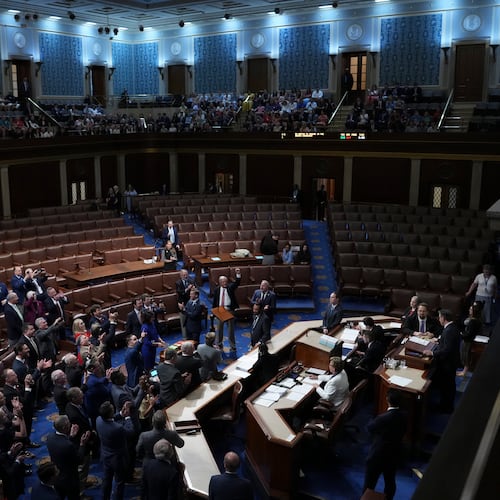Maj. Gen. William Tecumseh Sherman, U.S. Army, stands accused of four counts of war crimes. By his own admission, he is guilty.
After World War II, the Nuremberg Charter defined war crimes as violations of the laws or customs of war. It lists several categories of offenses. Let us see how Sherman, on his own authority and under no orders from his superiors, violated the laws and customs of war.
Murder or ill-treatment of civilians: Union artillery had barely gotten into range of Atlanta when, on July 19, 1864, Sherman ordered a bombardment of the city's buildings: "No consideration must be paid to the fact they are occupied by families, but the place must be cannonaded." The Yankee guns fired their first shells on July 20, and within a few days, Confederate newspapers began reporting casualties. One shell wounded a woman and killed the child she was carrying in her arms. In my book, I have concluded that the victims were the wife and child of John M. Weaver, an engineer who lived on Walton Street.
Sherman maintained a perverse determination to shell Atlanta, denying that innocent civilians still lived there. “You may fire from 10 to 15 shots from every gun you have in position into Atlanta that will reach any of its houses,” he ordered his artillery on Aug. 1. “Fire slowly and with deliberation between 4 p.m. and dark.”
Three weeks later, the bombardment ceased only because Sherman gave up on his semi-siege of Atlanta and led most of his army toward Jonesboro to break the Rebels’ railroad supply line (this he did on Aug. 31, forcing Confederate evacuation of the city the next day). Civilian casualties of Sherman’s 37-day bombardment are hard to count, but I estimate about 25 dead, and two or three times more wounded.
Deportation of civilian population in occupied territory: On Sept. 4, just days after his troops entered Atlanta, Sherman dictated his Special Field Orders 67: "The City of Atlanta being exclusively required for warlike purposes, will at once be vacated by all except the Armies of the United States." Civilians wishing to go south would be taken to Confederate lines under truce flags; the Rebels would then have to transport them on to Macon. The displaced could take some possessions, but most of their property, not to mention their homes, would be left behind.
The real shock was that Sherman expelled even those Atlantans who were Northern sympathizers (“secret Yankees”). They and their belongings would be taken by train to Nashville or other points north. Eventually, some 1,650 men, women and children were dumped into Confederate lines south of the city during September. (A handwritten list of their names is in the National Archives.) Probably an equal number went north. Sherman’s forced expulsion of Atlanta’s civilian population has been called by historian Mary Elizabeth Massey “the single largest forced evacuation of an entire city during the Civil War.”
Plunder of public or private property: Maybe 50 families were allowed to stay during the Union occupation, which lasted till mid-November. This meant that most of the houses in the city were abandoned. Union officers moved into the nicer ones, but most of the Northern troops camped outside of town. To build their huts, the Yankees tore down houses, outbuildings and shacks. Sherman's Field Order 67 allowed "buildings, barns, sheds, warehouses and shanties" to be so used, and they were. "All around fine houses are leaving, by piece-meal," wrote one of Sherman's men, "on the backs of soldiers. All these, to fix up quarters." For the civilians who came back to find their homes gone, Sherman would simply have told them that war is war — a kinder phrase than the one he is more famous for.
Wanton destruction of cities, towns or villages: Before he left Atlanta on his March to the Sea, Sherman ordered the destruction not only of railroad depots, factories, shops and warehouses in Atlanta, but whole blocks of the downtown business section along Whitehall and Peachtree streets. The engineers knocked down what they could, then blew up or burned what was left. Soldiers saw that "the engineers were having all the fun," as one put it, and set fires of their own throughout the city. Sherman never ordered the wholesale burning of Atlanta. He didn't need to; he knew what his veterans would do when he looked the other way.
“The boys commenced burning every house in (the northwest part) of the town,” wrote Capt. James Ladd of the 113th Ohio. “The wind was blowing hard at the time, and soon that part of the city was gone.” We’ll never know how much of Atlanta was burned before Sherman rode out on Nov. 16. Estimates run from a quarter of the city to 80 percent or higher. Sherman was satisfied, as he announced later in a field order congratulating his men: “We quietly and deliberately destroyed Atlanta.” The Yankees’ destruction was not quiet, but it was certainly deliberate.
A few years ago, I participated in a “mock trial” of General Sherman, staged by the historical society of Lancaster, Ohio, his home town. I was invited up to serve as prosecutor. We lost, of course: The three judges were Lancastrians playing U.S. generals, and the gallery was also stacked against us. It didn’t matter: I and my Southern witnesses argued our case strongly and passionately. In my closing statement, I addressed the judges: “Go ahead and justify him! Nobility, decency and civility have already been vanquished, ground into the red clay of Georgia by the heels of 100,000 Yankee soldiers under the direct command of William Tecumseh Sherman!”
I rest my case.
Civil War historian Stephen Davis of Atlanta is the author of “What the Yankees Did to Us: Sherman’s Bombardment and Wrecking of Atlanta.”
About the Author
Keep Reading
The Latest
Featured


